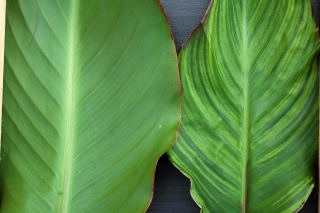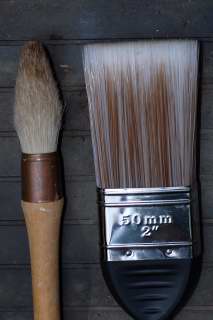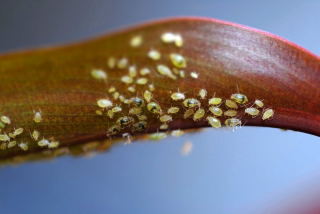Canna pests and diseases
One problem to be aware of these days is the canna virus. This is a virus that seems to serve no purpose other that distort and discolour the leaves of your plants. One of the hazards of buying dormant rhizomes is that you only have the word of the supplier that they virus free. If you introduce sick plants to your garden, the virus can be spread by aphids onto your healthy plants.
That aside, buying rhizomes is the most cost effective way of buying a specific variety. Many nurseries now only sell growing plants in order to ensure they are not selling you a dodgy plant. The draw back however is price.

The virus manifests itself as a crinkled leaf. However if you are 'forcing ' your plants into growth using a heat mat, very often the first couple of leaves will be crinkled and distorted. Once the plants are removed from the heat mat normal leaf formation should follow. If you find that the subsequent leaves are distorted, chances are you have a virus.
The leaves may also show signs of speckling or streaking.
If you suspect you have a virus throw the plant away. Do not compost it.
Canna leaf virusxxxxxxxxxxxxxx goThe leaf on the left is a healthy canna warscewiczii leaf. The other shows both distortion and streaking. Both of the plants in this instance were seed grown. Although growing canna from seed is meant to avoid the virus it does not prevent them from catching it.
This brings us on neatly to the little buggers who theoretically spread the virus...
Aphids
Aphids are a particular problem when growing canna or other tropicals in a greenhouse. Regardless of whether you are growing from seed or rhizome, as soon as the first shoot appears, it attracts aphids. It is crucial to keep a regular eye on your plants. Just a few days negligence can lead to an explosion in numbers.
So how can we control them. You can of course spray, but I am not a fan of chemical extermination. Preventing the numbers building up is the best course of action. Regular inspection of your plants is essential. Particular attention must be paid to the undersides of the leaves as this is their favourite haunt. Once you have found them you need to eliminate them.

Theoretically all you need to do to them is brush them from the plant. They have very delicate mouth parts which are destroyed when you brush the aphids off the plant. With smaller plants I just simply run my fingers up the unfurling leaves to remove the aphids. If you are not keen on coming into direct contact you may find a small soft paint brush is useful. On larger leaves and for heavy infestations a soft paint brush is the tool for the job.
When brushing the aphids off, try not to do it directly over other plants just in case there are any flaws with the above theory. To be on the safe side, I usually give any dislodged aphids found wandering around the compost surface, a gentle push towards the soil with my finger tip.
ARD (Aphid Removal Device)xx goAnother way to reduce numbers is by not giving any supplementary feeding to the plants. There should be sufficient food in the compost for your plants to grow, especially if you pot them up regularly. Feeding the plants with a soluble feed produces lots of sappy growth which is exactly what the aphids crave.
I saw a TV program once where an organic gardener was denouncing synthetic soluble feeds for this very reason. The person in question recommended a liquid organic feed. The next year I duly purchased some organic liquid feed. Not only did it smell as if it had been filled directly from a cesspit, the aphid infestations were the worst I had ever experienced. I lost half of my plants to virus whilst still in the greenhouse.
Now I do not give any extra feeding and the infestations are much more manageable.

Once the plants go out into the garden, it is up to the natural predators to deal with the aphids. Ladybirds and hoverflies are your allies.
As for biological control in the greenhouse, it is pretty ineffective unless you throw a ton of money at the problem and buy your predators by the bucketful. Mine either flew out of the windows or into the mouths of some very appreciative carnivorous plants. The exercise however does teach you to recognize which are the beneficial insects around your garden.
Aphid infestation on the underside of a canna leaf goSlugs and Snails
Slugs and snails are more of a pain when you leave your plants in the ground over winter. As your plants begin to grow they provide a tasty morsel to any passing mollusc. Slugs are particularly fond of the leaves when they are tightly wound. This creates some interesting but undesirable patterns when the leaf unfurls. Vigilance at this crucial stage can help to eliminate damage.
I am not a fan of pellets as they are an indiscriminate poison. They target both pests and predators. Pellets are baited and as a result encourage slugs and snails into your garden.
Traps...The thought of emptying slug traps full of bloated, beer stenched slug carcasses, is not high on my list of priorities.
I prefer search and destroy missions. Once you've taken out your first slug it becomes second nature. Make it quick though, you will sleep better as a result. A common hiding place for slugs is under the long grass at the border of the lawn and flower bed. These areas are shady and moist providing a good base for hit and run missions. Keep the edges of your lawn tidy!

